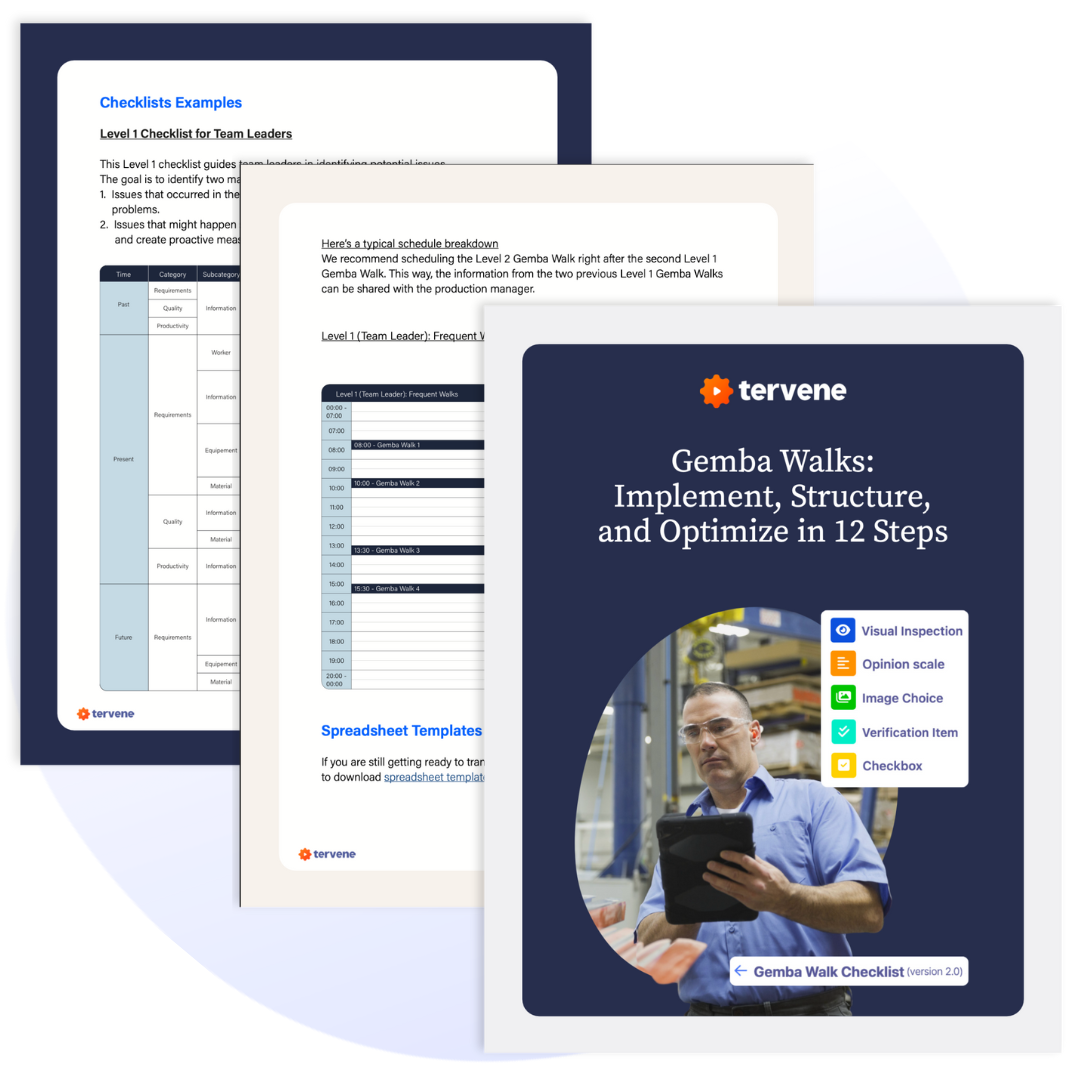How Gemba Walks Sustain a Strong Continuous Improvement Culture in Factories

| Audience: | Manufacturing and Healthcare Executives, Lean Management and Continuous Improvement Professionals, Operational Leaders and Safety Officers |
| Last updated: | September 11, 2025 |
| Read time: | 6 min |
- Fuel for Kaizen: Walking the floor uncovers recurring problems and transforms them into concrete improvement opportunities.
- Engaged teams: From frontline workers to executives, everyone contributes insights, building ownership and accountability.
- Structured progress: Standardized walks bring context, align improvements with strategic goals, and free managers to focus on long-term projects.
What is a Gemba Walk?
In manufacturing, a Gemba Walk is the action of walking around a factory floor where operations take place in order to reduce Waste and improve processes. Managers perform this operational control to identify discordances with the standard and raise issues. A Gemba Walk is a proactive problem-solving practice of operational control and improvement in factories.

What is Continuous Improvement?
Also known as Kaizen, continuous improvement is a continual activity that aims to improve processes, products, and services by eliminating recurring issues, reducing waste activities and enhancing value-added activities.
9 Reasons Why Gemba Walks Sustain Kaizen
- Gemba Walks feed the system with opportunities for improvement.
- They are two complementary practices.
- Workers from all levels can contribute to the improvement process.
- Gemba Walks bring context to the proposed improvement opportunities.
- It gives managers more time to focus on the improvement of projects.
- It increases supervisors and managers’ commitment.
- Systematic Gemba Walks standardize the identification and documentation of opportunities.
- The improvement is consistent with the strategic objectives.
- The implementation of a Gemba Walk structure in itself can be an improvement initiative.
Industry leaders leverage Tervene to structure their Gemba Walks

1. Gemba Walks feed the system with opportunities for improvement
The Gemba Walk is a lean practice that sustains a company’s continuous improvement culture. Recurring issues raised through Gemba Walks are improvement opportunities.
Supervisors and managers can identify daily issues or deviations from the standards and generate improvement opportunities from these issues.
Issues are raised and logged directly where the operations are and where they originate. That way, improvement relies on issues and Wastes experienced directly on the floor. It brings relevant and concrete opportunities for improvement.
2. They are two complementary practices
Gemba Walks’ goal is to identify issues and act on them proactively before they impact quality, productivity, deadlines, and health & safety.
One of the continuous improvement goals is to continually reduce Waste by eliminating recurring issues once and for all. Continuous improvement requires collecting improvement opportunities from a previous detection of issues or from sought out and spontaneous ideas.
Gemba Walks aim to proactively detect issues and generate improvement opportunities. Continuous improvement gets rid of these recurring issues. Combined, they lead to an enhanced control and an improvement of operations.
3. Workers from all levels can contribute to the improvement process
Since all management levels should go on Gemba Walks, managers can raise all types of issues, as well as generate improvement opportunities. All managers validate and take action in accordance with their management level, which provides a complete view of opportunities. Also, Gemba Walks facilitate the transfer of issues and opportunities among all levels of management for a bottom-up improvement approach.
With Gemba Walks as an operational control practice, supervisors handle all lines and departments; none are avoided or left aside. It creates a discussion with all employees on the floor that focuses on improvement. Everyone contributes to the improvement process, from frontline workers, team leaders, supervisors, managers, and directors.
Workers are valuable sources of improvement ideas for their department. Engaging frontline teams and employees in the changes begins with the identification of improvement opportunities.
4. Gemba Walks bring context to the proposed improvement opportunities
Managers raise improvement ideas directly where the problems originate or proactively before they occur and document them not long after the floor tour. This method standardizes how they document improvement ideas.
A thorough documentation of issues provides a more precise understanding once it is time to take action. Moreover, the more information we have about the problematic situation, the easier it is to implement a solution that solves the problem at the source. Supervisors and team leaders get to see the complete history of identification and thus, where the ideas originate.
In the PDCA cycle, Gemba Walks help with the identification of the problems, the analysis of the situation and the creation of a proper action plan. It provides an impartial judgement of the improvement ideas and reduces the daily bias based on what the flavour of the day might be.
Relevant Tervene tools
5. It gives managers more time to focus on the improvement of projects
A reactive problem-solving approach never helps with the managers’ busy schedule. In a reactive approach, the detection and the resolution of issues is anecdotal. The detection of issues as well as the resolutions are too anecdotal and reactive. Thus, problems already have an impact on the objectives even before managers can address them. Managers have less control of their time management and have a hard time freeing up time to manage improvement projects
Gemba Walks promote a proactive problem-solving. Supervisors and team leaders gain time when new problems don’t arise randomly. Since the problems can be identified before they come up, they can be solved on-the-spot with less or no impact on objectives. It is a time-saving operational control which provides more time to focus on improvement.
Managers move from a firefighter mode to proactive and controlled operations.
6. It increases supervisors and managers’ commitment
One of the challenges for operations managers is promoting a culture of accountability and ownership from all levels of management. It implies commitment towards improvement activities.
Gemba walks help continuous improvement by structuring the identification of opportunities. The easier it is to conduct, the better the adherence to the improvement practice will be. Gemba Walks ensure the systematic presence of supervisors on the floor. It also increases workers’ commitment towards company objectives with a bottom-up improvement practice.
On top of that, we recommend setting goals over their Gemba Walks for how many new improvement opportunities each team leader should come up with every week.
7. Systematic Gemba Walks standardize the identification and documentation of opportunities
Traditional methods such as the suggestion box or other intermittent and occasional practices do not ensure a continual flow to identify improvement opportunities.
With a standard and daily Gemba Walk structure, organizations standardize the way they identify, log, and document improvement opportunities. Supervisors and team leaders go directly on the floor to ask questions and raise ideas for improvement.
8. The improvement is consistent with the strategic objectives
The validation list can be built in a way that aligns the detection of issues with the organization’s improvement priorities. That way, managers can validate questions which will help to focus on the right objectives. It facilitates the detection of improvement opportunities in accordance with priorities to focus on value-added activities.
9. The implementation of a Gemba Walk structure in itself can be an improvement initiative.
A way to improve an existing Gemba Walk structure is by perfecting checklists, schedules, goals, priorities and management behaviours.
On the other hand, the implementation of a Gemba Walk structure with standard checklists and schedules is an improvement project that enhances operational control on the factory floor.
Furthermore, some organizations implement a Gemba Walk dedicated to improvement, committed to chasing down Waste.
Tervene's Gemba Walk Tools and Free PDF Checklists

Gemba Walks: 12 Steps, Checklists & Templates
Mobile Gemba Walk App & Audit Software
Managers use issues and nonconformities from audits, and Gemba walks to generate ideas for improvement. Users link pictures, log relevant information and repercussions.
Continuous Improvement Manager
Tervene’s Continuous Improvement Manager consolidates the most important parts of the improvement process in an all-in-one solution. Improvement managers:
- Align improvement with the organization’s strategic objective.
- Log and document proposed improvement opportunities.
- Prioritize improvement opportunities.
- Manage improvement action plans in collaboration.
- Control improvement projects once implemented.
FAQ on Gemba Walks & Continuous Improvement
A Gemba Walk is the practice where managers and leaders walk on the factory floor (“the Gemba”) to observe processes, detect issues, reduce waste, and identify improvement opportunities directly at the source.
Gemba Walks feed the Kaizen system by identifying recurring issues and waste. Continuous improvement then eliminates these issues, creating a cycle of proactive problem-solving and sustainable operational excellence.
Supervisors, middle managers, and directors should all conduct Gemba Walks at different frequencies. This ensures a complete bottom-up and top-down improvement approach, with contributions from every management level.
The benefits include:
-
Detecting issues proactively before they impact operations
-
Engaging employees at all levels in problem-solving
-
Standardizing issue identification and documentation
-
Aligning improvements with strategic objectives
-
Saving managers time by reducing firefighting and reactive problem-solving
The frequency depends on management levels: supervisors may perform them daily, middle managers weekly, and directors monthly. A structured schedule ensures systematic improvement opportunities.
Unlike inspections that focus mainly on compliance, Gemba Walks emphasize observing real work, engaging employees, raising improvement ideas, and eliminating root causes of recurring issues.
By involving frontline workers and managers in discussions during the walk, employees become active contributors to process improvements. This fosters ownership, accountability, and a stronger culture of continuous improvement.
Yes. Establishing structured Gemba Walk checklists, schedules, and goals is itself an improvement project that enhances operational control, strengthens communication, and drives Kaizen.
Keep on Reading: Proactive Practices That Drive Results

Learn how to structure effective floor tours, ask the right questions, and uncover issues before they escalate. A practical guide for managers who want to connect directly with daily operations.

Not all CI tools are created equal. Discover the must-have features that help organizations sustain momentum, track KPIs, and turn ideas into measurable results.

Here’s what to look for in a digital Gemba Walk app if you want your teams to capture insights and act fast.


























